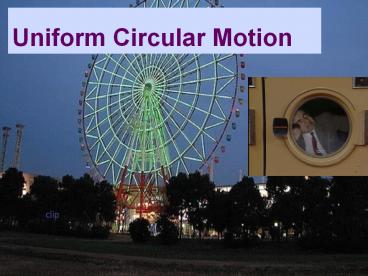Uniform Circular Motion - PowerPoint PPT Presentation
1 / 17
Title:
Uniform Circular Motion
Description:
Title: Circular Motion Author: pquacken Last modified by: jane Created Date: 10/24/2002 9:49:30 PM Document presentation format: On-screen Show (4:3) – PowerPoint PPT presentation
Number of Views:313
Avg rating:3.0/5.0
Title: Uniform Circular Motion
1
Uniform Circular Motion
clip
2
- A cycle is one unit of
- motion that repeats.
A period (T) is the time it takes for one
complete cycle, usually measured in seconds (s).
Blue ball revolves around the red dot in repeated
cycles.
What is the period of each ball?
3
Frequency
- The frequency is the number of cycles per unit
of time. One common unit for frequency (?) is
the hertz (Hz). - 1 Hz cycle/second
Does ball A or B have the highest frequency?
4
Period and Frequency are inversely related. As
period increase, frequency decreases.
5
Objects in uniform circular motion maintain a
constant linear velocity, also known a
tangential velocity, due to its inertia.
6
Tangential velocity the instantaneous linear
velocity of an object along the tangent to the
objects circular path.
vt
- Linear velocity equation
- For an object in uniform circular
- motion
- T period of time for one revolution
7
Objects in circular motion are accelerating.
- By definition, acceleration is a change in
velocity. Since velocity is a vector quantity,
acceleration may be a change in speed, direction
or both.
8
Centripetal Acceleration
- Objects that move in circular
- paths are accelerating, even
- when they are traveling with
- constant speed, because
- they are constantly changing
- direction.
Tangential velocity
radius
9
Centripetal vs. Centrifugal
- Centripetal forces-
- real forces that are directed toward the
center of an objects circular path. - (friction, tension, gravity, etc.)
- Centrifugal forces-
- not truly forces because they are
attributable to inertia. - (no actual unbalance force pushing out)
10
- Remember F ma?
- Accelerations are the result of an unbalanced
force acting on an object. - For objects in circular motion, the unbalanced
force that produces circular motion is called
centripetal force.
11
Centripetal Forces
Centripetal forces are directed toward the center
of an objects curved path.
Centripetal forces are always unbalanced forces
because they result in centripetal
accelerations accelerations that change the
direction of an objects path.
12
You Cant Always Trust What You Feel
13
Frames of Reference
The passengers inertia is straight forward while
the centripetal force is inward.
14
A Satellite
What is the centripetal force(s) that keeps a
satellite in a circular path around the earth?
15
Car Rounding a Curve
What is the centripetal force(s) that keeps a car
on the road while its turning?
16
In the Gravitron
What is the centripetal force (s) acting on a
person in a Gravitron ride?
17
Example Problem
- A test car (m 800 kg) moves at a constant speed
around a circular track. If the car is 48.2
meters from the tracks center, and takes 20
seconds to go around the track, - (a) What is the tangential speed?
- (b) What is the centripetal acceleration?
- (c) What is the centripetal force exerted on the
car?
Given T 20 s r 48.2 m m 800 kg
(a) vT 2?r/T 2 ? (48.2m) / 20 15.1 m/s
4.7 m/s2
(c) ??Fc mac (800 kg)(4.7 m/s2) 3760 N































